Ornamental Flowers – Paint with Me!
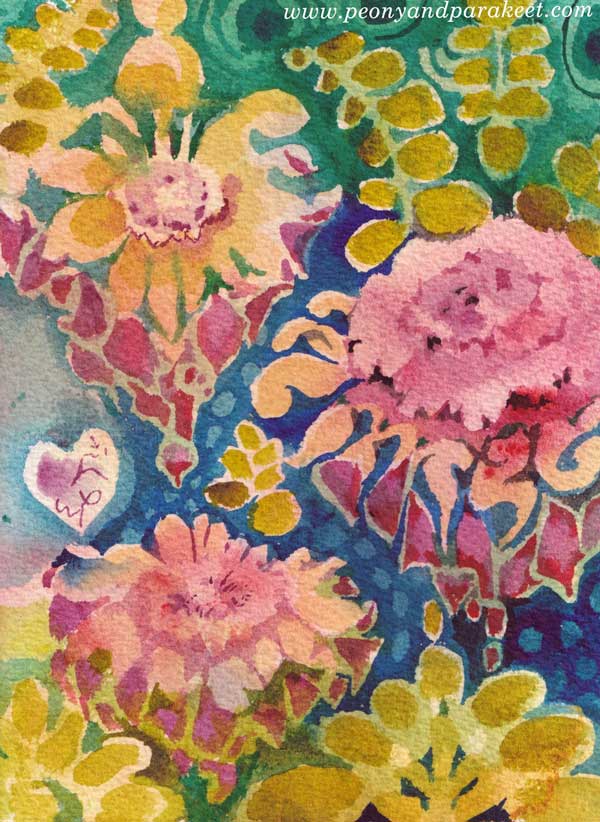
This week, I have a video tutorial for you! Let’s paint a watercolor card that’s like a piece of beautiful floral wallpaper. Watch the video!
Flowers have always been my favorite, but now even more than ever. I hope you’ll enjoy painting this!
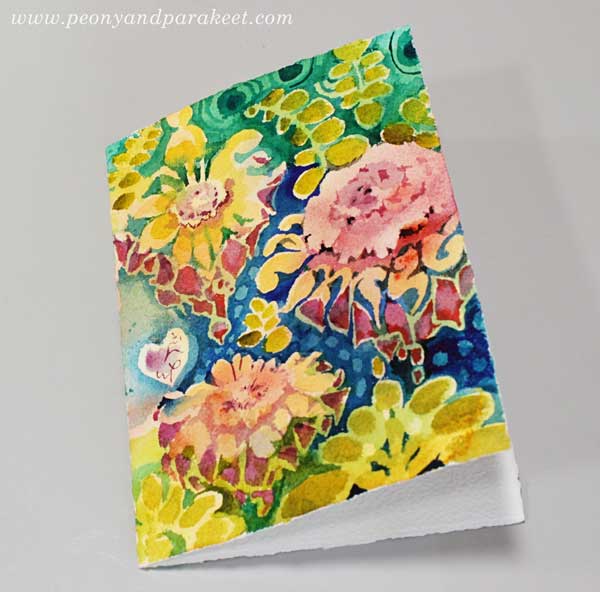
Floral Fantasies – Weekend Sale!
I am also happy to announce that Floral Fantasies – my flower painting class is now available again!
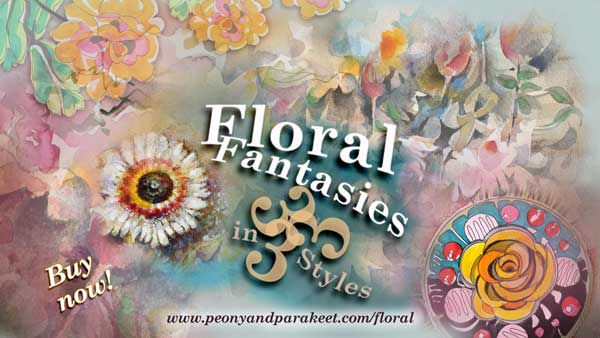
Honestly, this is the class to take when you want to become a floral painter + it’s for sale April 23-26 (PDT)! >> Buy here!
Paint Spiritual Energy – Step by Step!

When there is a big crisis in the outer world, it’s important to protect and strengthen the inner world. In this project, we paint spiritual energy with loose strokes, continue it to form a face, and then add a protecting frame around the painting. I find this project soothing and healing. I hope it makes you pick the brushes again too!
A) Where to Paint?
I have made these paintings on my newest art journal which is a black Dylusions Creative Journal. It is my third Dylusions Creative Journal, and I really like this product. It’s durable, the paper is thick, and it can be closed with an elastic band.
My first two Dylusions Creative Journals were large ones, but the newest one is a bit smaller, the page size being 8 by 8 inches.
The links above are Amazon.com affiliate links to product pages.
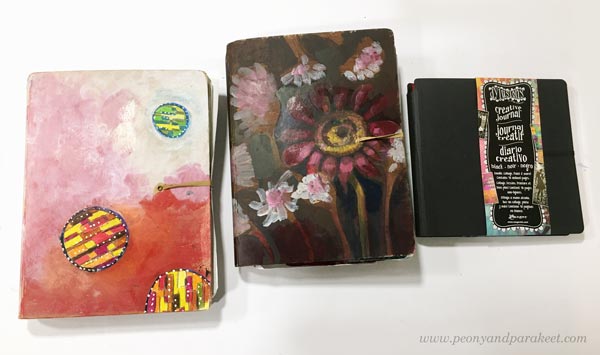
Watch the flip-through videos of the first two art journals! See these journals in practice and to get more inspiration:
Journal 1 Flip-Through
Journal 2 Flip-Through
B) Collage or Painting?
This project can be made as a painting or as a collage where you paint the figure separately from the rest of the image.
When I did this project the first time, I made a collage. I painted the profile on a paper, cut it out, and glued on the art journal page, and then continued painting the background and adjusting the facial features. In the photo below, the white line shows how I cut the face.
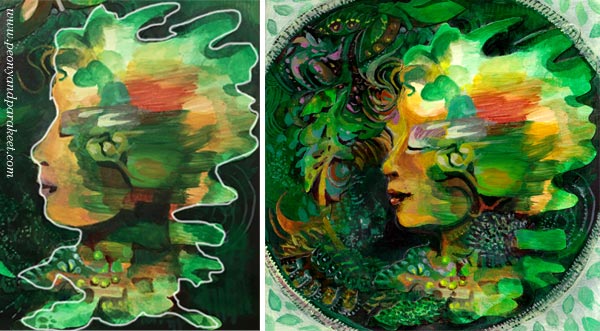
If you choose the collage technique, it’s good if the paper is not too thick. I used Bristol paper, which is fairly sturdy but thinner and easier to attach than thick watercolor papers.
C) Pick the Colors that Bring Energy!
I painted the second version directly on an art journal page.
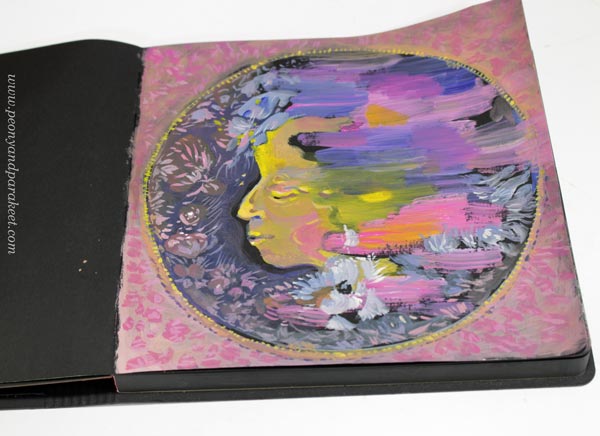
Both versions have a limited color palette. By picking only a few colors, they come alive and express energy more effectively than if you work with all the possible colors. So, choose the colors that energize you – that you feel drawn to at the moment.
I recommend choosing three different tubes of acrylic paint and adding white to the mix as well. If none of your colors is dark, pick black or another dark color so that you get a strong image with good contrasts.
For the first version, my colors were these (+ Titanium White):
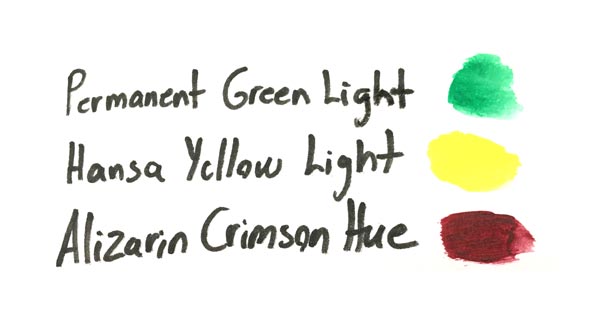
For the second version, my colors were these (+ some Mars Black for finishing)
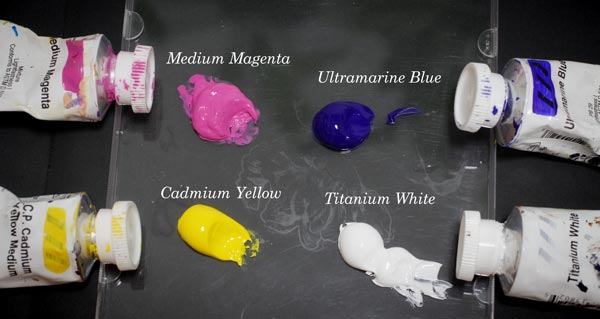
My acrylic paints are Golden Headybody Acrylics.
D) Paint Spiritual Energy!
Let’s create some abstract art! Use selected colors and paint with horizontal strokes. Mix white to get lighter strokes and make muddy mixes to get tones that make the pastels shine. Enjoy the colors and making most of the narrow selection.
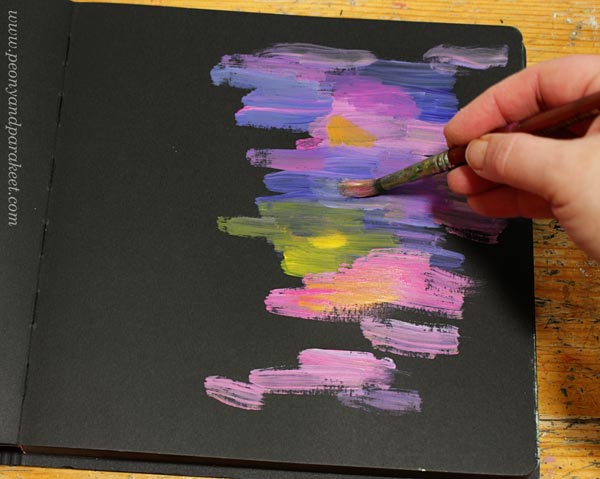
If you paint directly on a page, mentally divide the page in half, and paint on the other side only. This way, you will have enough room for the face.
E) Sketch the Face!
Pick a pencil and sketch a profile. You can adjust it later by painting, so focus on the location of the face more than the actual look. I used a white pen in the photo below so that you can see my sketch clearly.
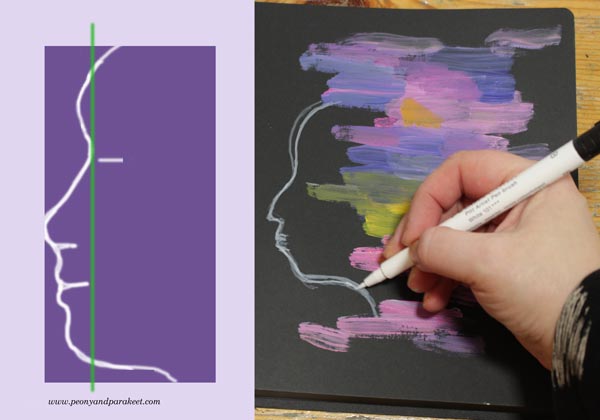
F) Draw a Frame!
Take a round object, for example, a plate, and draw a protective frame around the person.
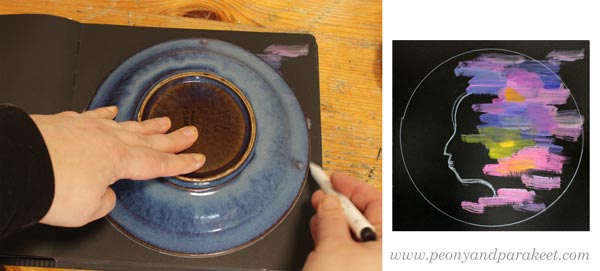
G) Paint the Face!
Paint the skin and facial features. Instead of outlines, paint shapes. Allow yourself to be more unconventional. Don’t paint bright white scleras or red lips but shapes that connect the person with the abstract part of the painting. In this project, the energy that the strokes represent is more important than the person herself.
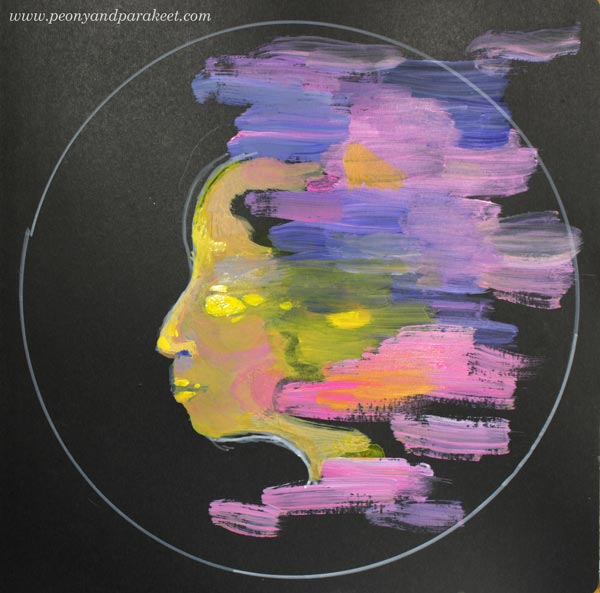
H) Paint the Background!
Surround the person with everything that soothes and heals. At this point, it can be just subtle strokes that will be more defined later, when you finish the painting.
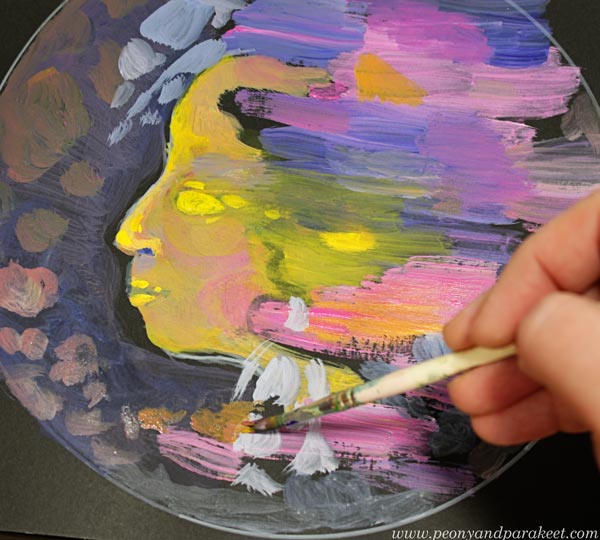
Paint the frame too. Use muted colors so that the frame doesn’t take the energy away from the person.

I) Finishing: Give Her All the Beauty She Needs
Paint details with a thin brush so that she will get all the softness and beauty she needs. Again, prevent using intense colors for the details on the background.
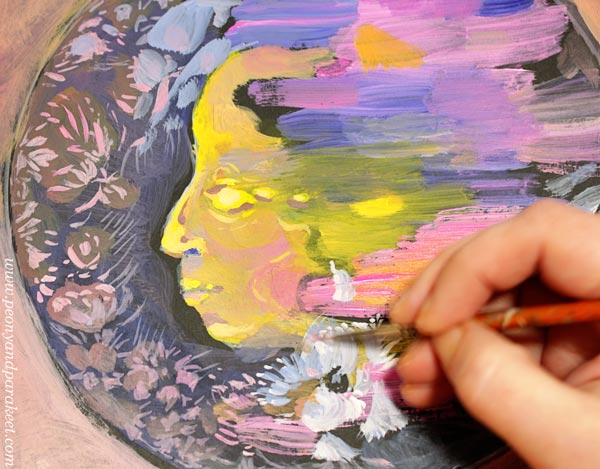
Connect her forehead with the beauty so that she is in the middle of the energetic strokes and more delicate and soft fillings.
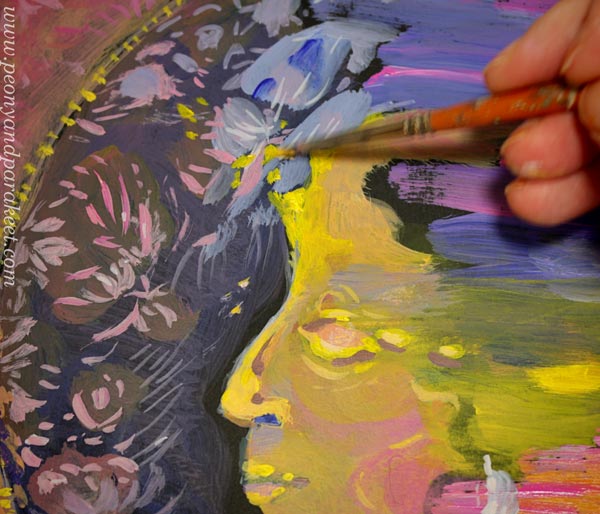
I also added some decorations on the frame.
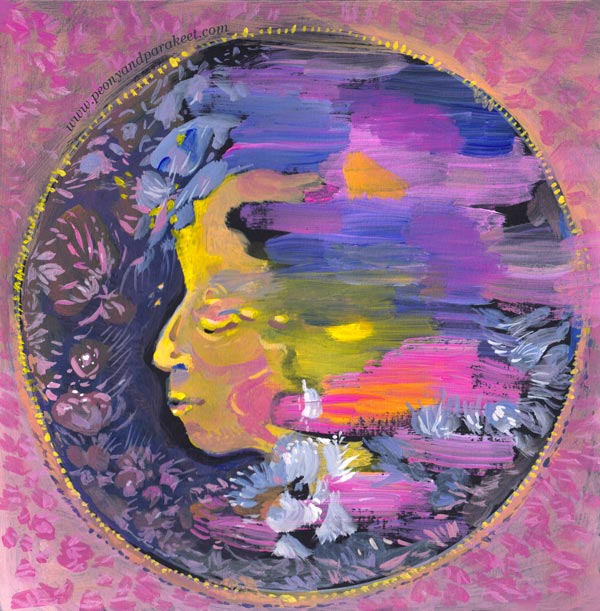
Less Control – More Energy and Expression
Art is freedom! In this project, we started with wild strokes and then built a portrait around them. These kinds of less-controlled uses of supplies are an important part of self-expression.
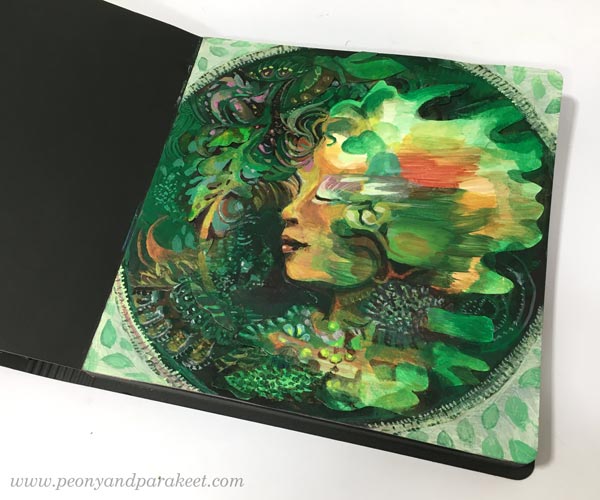
On Thursday, March 26, 2020, I will be talking about doodling and how to expand it to various supplies and styles in my art community Bloom and Fly. The session will be recorded too. If you have bought my class this year, you are invited! I have sent an email to the members yesterday.
How to join Bloom and Fly for 2020?
>> Buy any of my classes!
Doodler’s Sampler Step by Step
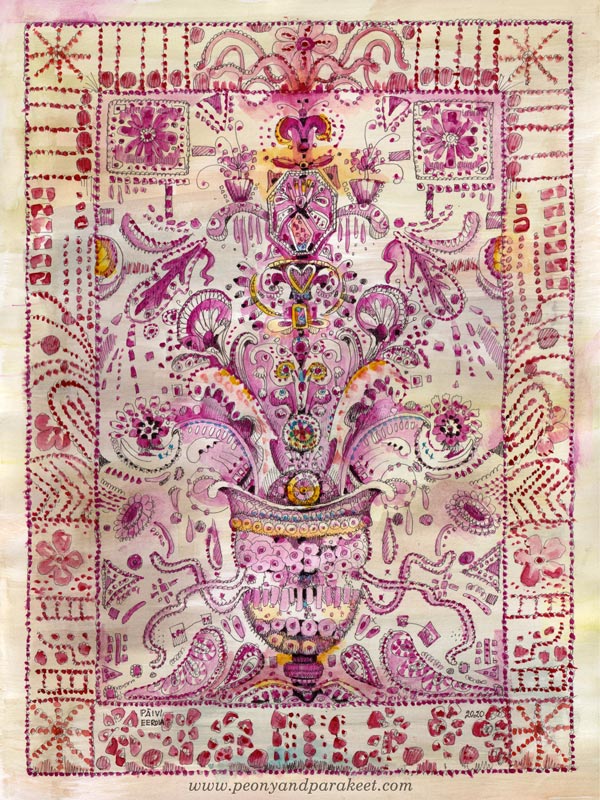
I have always loved antique embroidery, and it inspires my art too. This week, I invite you to treat your pen as a needle and doodle the look of the precious hand-stitched fabric. My drawing – I call this Doodler’s Sampler – is 9 by 12 inches but you can make a smaller or bigger piece with these instructions. The best paper for this is Bristol paper. It’s smooth and nice to color with watercolors.
Step 1 – Draw a Grid
Because we aim for ornamental stiffness, a grid helps to place the elements. Use a pencil so that you can erase the lines before coloring. Start by outlining a space for a frame. Then divide the rest of the paper so that they help to place the main elements.
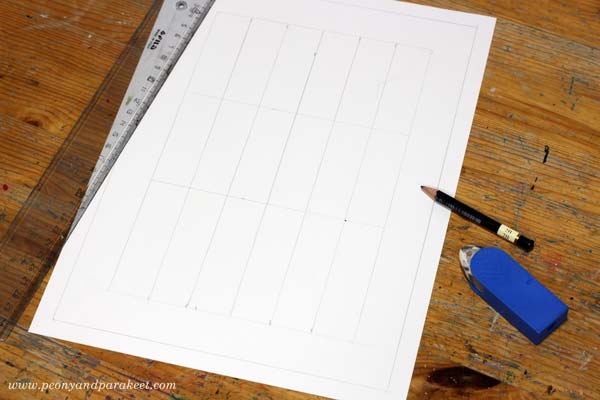
I wanted my Doodler’s Sampler to be symmetrical, so I drew a vertical centerline, and then divided the two halves into three parts. Another idea that I had was to have a vase of flowers. So I drew horizontal lines that mark each third, and the lowest third is reserved for the vase.
Step 2 – Sketch the Structure
Old samplers are filled with decorations but at the beginning, it’s enough to sketch the places for the biggest elements and their shapes.
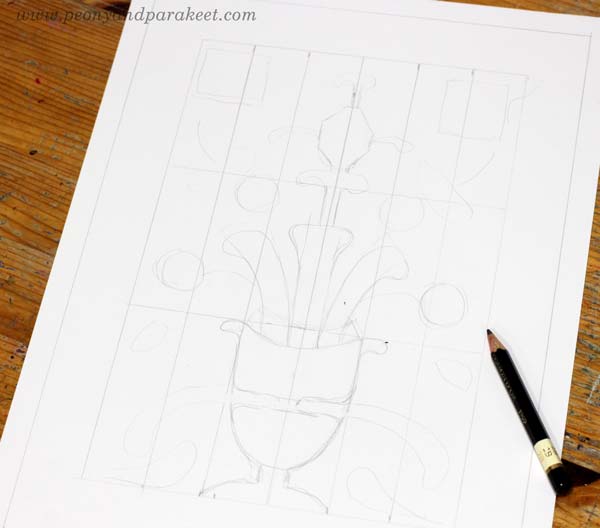
I wanted to have something rectangular on the top corners, the vase on the bottom, plant-like organic shapes coming out of the vase, and then an angular jewel-like thing on the top of the ornament.
Step 3 – Doodle and Decorate
Pick a thin-tipped drawing pen, that has permanent ink, and start doodling! Make more shapes and fill them with circles, rectangles, flowers, hearts, anything you can think of!

My pen is Copic Multiliner, tip size 0.05. I add shadows to my doodles so that they don’t just outline the shapes but there are darker parts too.
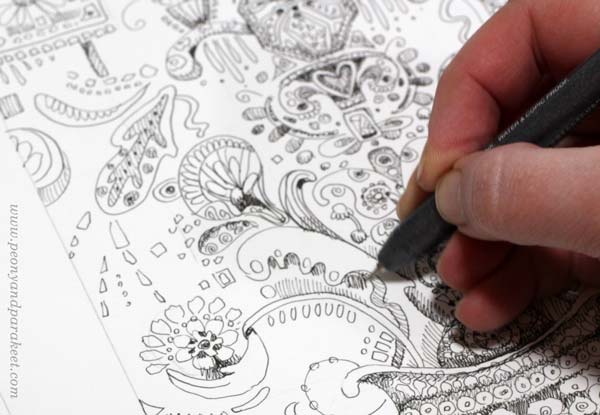
I make the decorative border simpler so that it doesn’t take the power away from the centerpiece. Trembling lines look more decorative than straight ones.
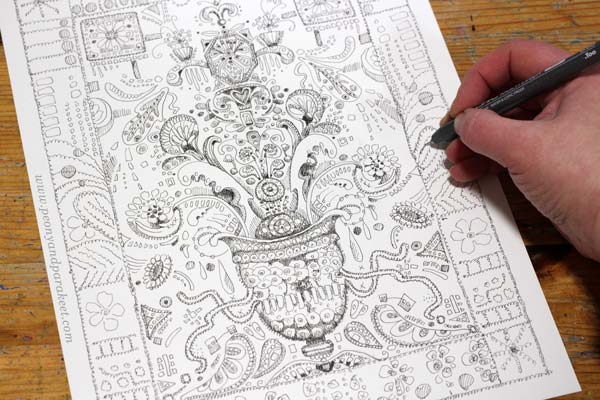
Here’s my Doodler’s Sampler after Step 3, ready for coloring.
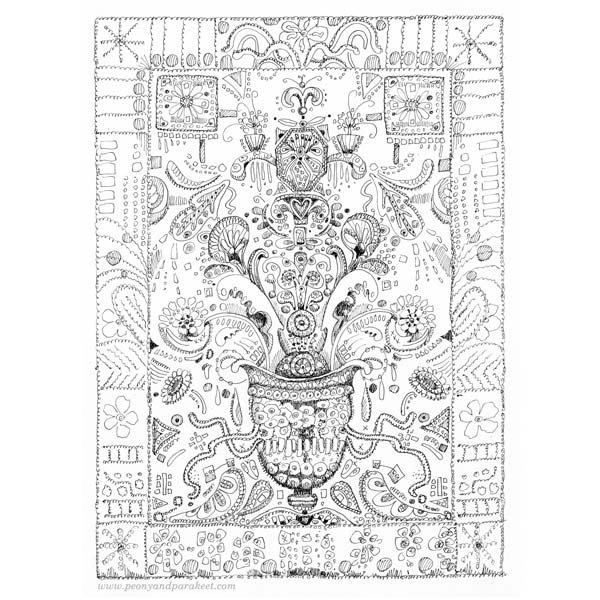
Step 4 – Color the Background
You can use any supplies for coloring, but in my opinion, the softness of watercolors complements the sharp black lines best. Start the coloring by adding some color to the background.

I use very little pigment and many tones so that the background looks like old antique linen.
Step 5 – Color the Doodles
Pick one main color for the sampler. My choice is cool carmine red. When coloring, add more decorations like dots and other decorative shapes. You can also color around a shape instead of inside the shape.
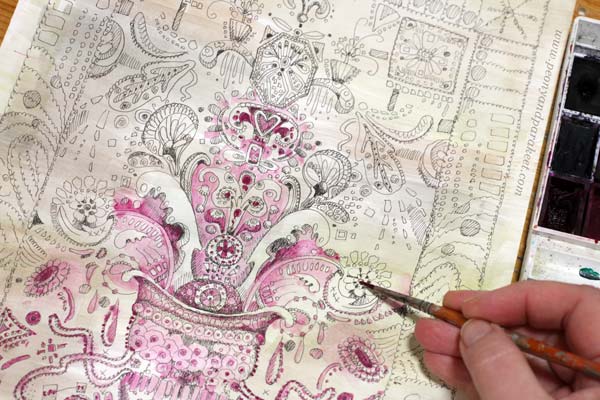
Pick slightly different tones for the frame. I use warmer red and a little bit of orange.
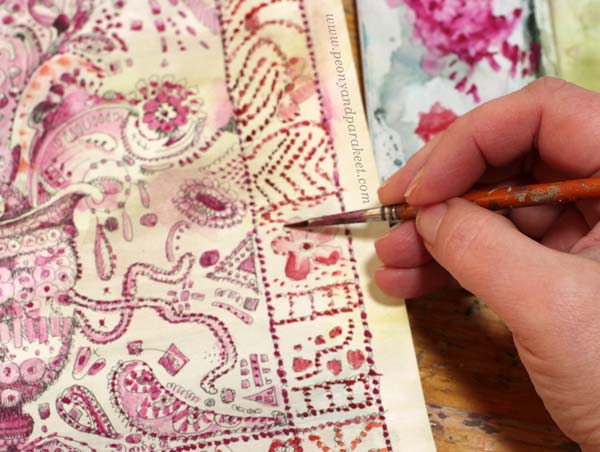
When you have colored the sampler with a very narrow color scheme, make it more lively with some new tones.
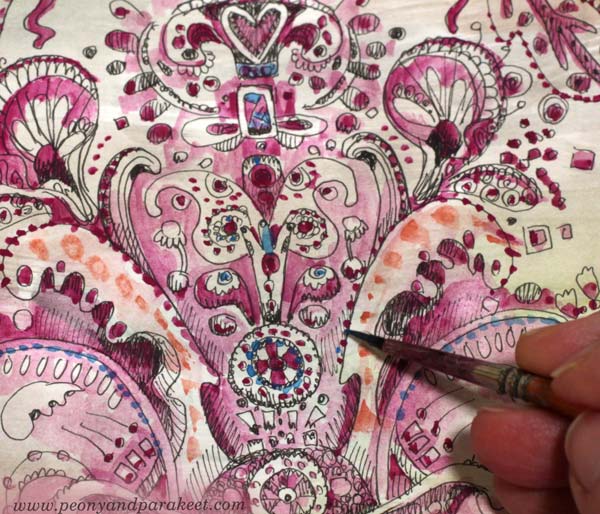
I added blue and yellow, but very sparingly.
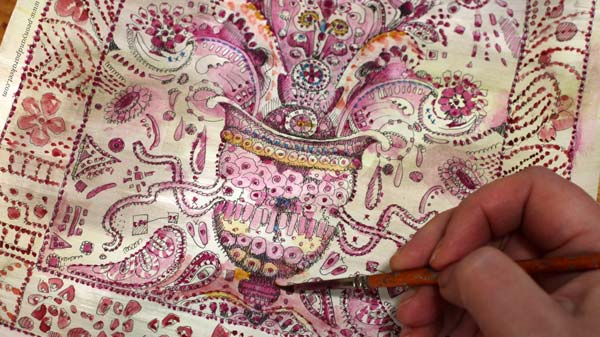
You can also highlight the main elements by making the darkest areas pitch black.
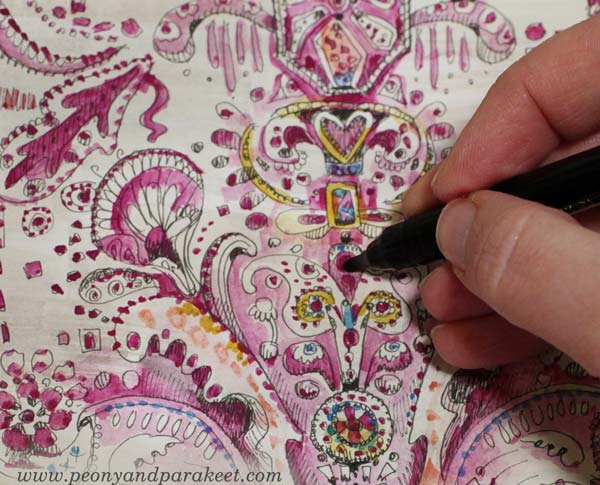
Here are the black and white version and the colored version side by side. Click the image to see it bigger!
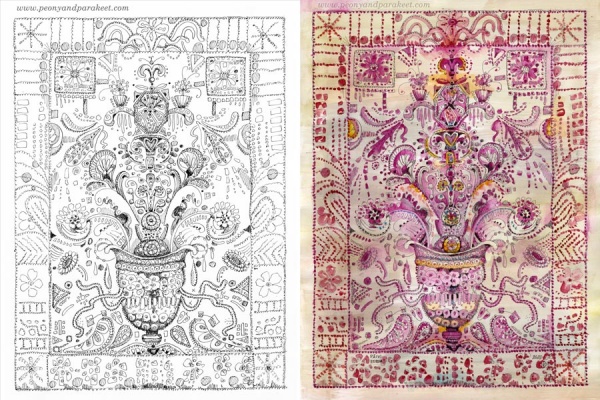
Doodler’s Sampler – For the Love of Flowers and Hand-Stitching
Henri Matisse has said: “I don’t paint things. I only paint the difference between things”. I think that to me, it goes like this: “I don’t paint things. I only paint the similarities between things.” So here’s for the love of flowers and hand-stitching!
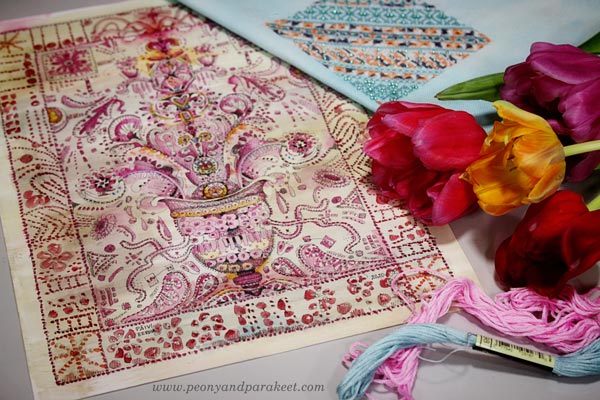
Draw more with me – Check the courses Animal Inkdom and Magical Inkdom!
Expressive Watercolor Card – Free Video Tutorial

This week I have a video tutorial for you. We’ll paint an expressive watercolor card that connects several artistic approaches together.
Fine Art, Illustration, or Design?
Visual art is often divided into categories like fine art, illustration, and design. I am not a one-category artist, but interested in all of them. I need to do fine art to let go and feel free. Illustrating connects me with the outside world and other people. And I have started creating surface designs again because simplifying is a game that keeps fascinating me, and I love to develop products.
This week, let’s create a card – you could also say “a product.” It has a clear structure, so “a design,” but it can also be an illustration with a message. My card is about a house filled with plants, and I think I am illustrating my home. Visitors sometimes comment: “Wow, you have a lot of houseplants!” Almost every room in our house has plants, and their welfare constantly worries us, especially during winter when there’s less daylight.
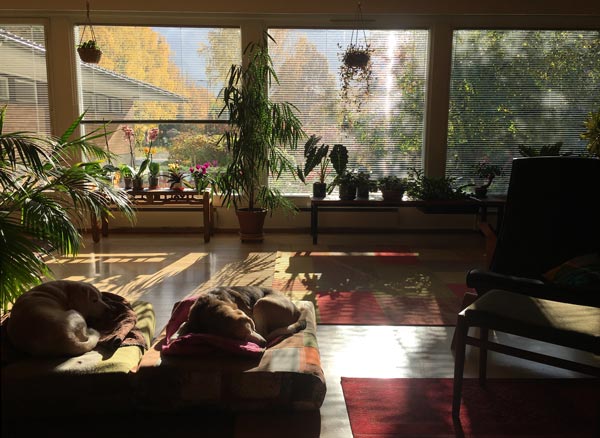
But this card is not an illustration at all when thinking about how it started. The way it’s created makes it fine art. I painted freely and didn’t have any pre-defined images or ideas for it. However, I had a method that can produce many kinds of images. So, the method gives practical guidelines for painting, but the result can be different each time.

Expressive Watercolor Card – Paint With Me!
Watch the video and start painting!
In the video, I use the negative painting technique a lot. Even if you can use any technique that suits you, negative painting is the best technique when you want to make lines and shapes more elegant and the painting more finished. Dive deeper into this wonderful painting technique in the class Magical Forest.
Magical Forest – Dive Deeper into Expressive Watercolor Painting

Learn essential watercolor techniques like negative painting and layering, and express with light! In Magical Forest, we paint magical nature sceneries with flowers, trees, water, and fantasy.
Hop along! The class ends as late as at the end of April, and you will get the published lessons right after the registration. >> Sign up here!